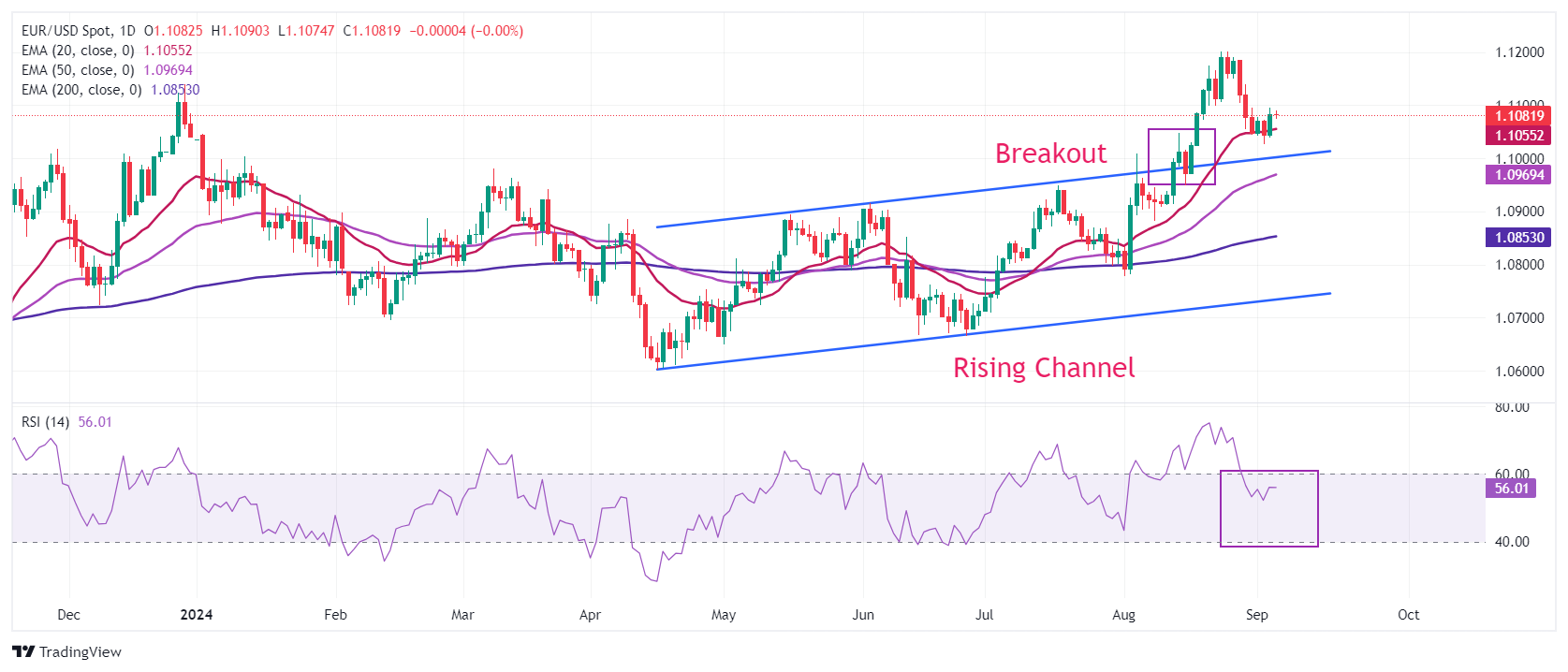- EUR/USD clings to recovery near 1.1100 as weak US job openings data puts the US Dollar on the defensive.
- The main trigger for the US Dollar will be the US Non-Farm Payrolls (NFP) report for August on Friday.
- The ECB is almost certain to cut interest rates this month.
EUR/USD is holding on to Wednesday’s recovery slightly below the round-level resistance of 1.1100 in the European session on Thursday. The major currency pair rebounded sharply on Wednesday following the release of weaker-than-expected United States (US) JOLTS job openings data for July, which raised market expectations that the Federal Reserve (Fed) will begin the long-awaited policy easing cycle in an aggressive manner.
A sharp rise in market speculation about a big interest rate cut by the Fed this month weighed heavily on the US Dollar (USD). The US Dollar Index (DXY), which tracks the greenback’s value against six major currencies, extended its decline near 101.20.
JOLTS job openings data showed job openings posted in July were lower at 7.67 million from a downwardly revised 7.91 million in June and below estimates of 8.1 million. The weak labor market data came as warning signs for the job market.
For significant updates on current labor market conditions, investors are looking ahead to the US nonfarm payrolls (NFP) data for August, due out on Friday.
In today’s session, the US Dollar will be influenced by the ADP employment change data and the ISM services purchasing managers’ index (PMI) for August, which will be released at 12:15 GMT and 14:00 GMT, respectively. Economists estimate that private sector payrolls increased by 145,000 from 122,000 in July. Over the same period, activity in the services sector is projected to have expanded at a slower pace, with the PMI settling in at 51.1 from the previous reading of 51.4. Upbeat private payrolls and services PMI data would dampen market speculation about large interest rate cuts by the Fed, while soft data would strengthen them.
Daily Moves and Market Movers: EUR/USD remains sideways after a strong recovery ahead of a data-heavy day in the US.
- EUR/USD is trading in a tight range below 1.1100, with investors focused on a slew of US economic data. In the Eurozone, investors are awaiting July retail sales data that will influence the next move for the Euro (EUR), due out at 09:00 GMT. Mainly, the Euro will be guided by market speculation on the European Central Bank (ECB) monetary policy in September, in which the central bank is expected to cut its key interest rates.
- Economists estimate that retail sales have grown by 0.1% after contracting by 0.3% in June both on a monthly and annual basis. A slight improvement in retail sales would be insufficient to dampen market speculation that the ECB will resume its policy easing cycle this month, which began in June, after a pause in July.
- The ECB is widely anticipated to cut interest rates this month as officials have remained concerned about the poor growth outlook, with confidence that inflationary pressures continue to steadily ease. ECB Governing Council member François Villeroy de Galhau said in an interview with Bloomberg last week, “There are good reasons for the central bank to consider cutting its key interest rates in September.” Villeroy added, “Unfortunately, our growth remains too weak.” He also added, “The balance of risks still needs to be monitored in Europe.”
- Meanwhile, concerns about growth in the Eurozone have deepened further as the final HCOB PMI report showed that overall economic activity expanded at a slower pace of 51.0 from the preliminary reading of 51.2. The composite PMI expanded moderately due to slower growth in the services sector and a continued contraction in the manufacturing sector.
Technical Analysis: EUR/USD eyes 1.1100 reclaim
EUR/USD is trading sideways near 1.1080 on Thursday after a strong recovery from a fresh two-week low near 1.1025. The near-term outlook for the major currency pair has improved as it manages to firm up near the 20-day exponential moving average (EMA) around 1.1055.
The long-term outlook is also bullish as the 50-day and 200-day EMAs at 1.0970 and 1.0865 respectively are sloping upwards. Moreover, the shared currency pair is holding the breakout of the ascending channel on a daily time frame.
The 14-day Relative Strength Index (RSI) has fallen below 60.00 after turning overbought near 75.00.
On the upside, the recent high of 1.1200 and the July 2023 high of 1.1275 will be the next target for Euro bulls. Meanwhile, the downside is expected to remain cushioned near the psychological support of 1.1000.
Euro FAQs
The Euro is the currency of the 20 European Union countries that belong to the Eurozone. It is the second most traded currency in the world, behind the US Dollar. In 2022, it accounted for 31% of all foreign exchange transactions, with an average daily volume of over $2.2 trillion per day. EUR/USD is the most traded currency pair in the world, accounting for an estimated 30% of all transactions, followed by EUR/JPY (4%), EUR/GBP (3%) and EUR/AUD (2%).
The European Central Bank (ECB), based in Frankfurt, Germany, is the reserve bank of the Eurozone. The ECB sets interest rates and manages monetary policy. The ECB’s main mandate is to maintain price stability, which means controlling inflation or stimulating growth. Its main instrument is to raise or lower interest rates. Relatively high interest rates – or the expectation of higher rates – generally benefit the Euro and vice versa. The Governing Council of the ECB takes monetary policy decisions at meetings held eight times a year. Decisions are taken by the heads of the national banks of the Eurozone and six permanent members, including ECB President Christine Lagarde.
Eurozone inflation data, as measured by the Harmonised Index of Consumer Prices (HICP), is an important econometric data point for the euro. If inflation rises more than expected, especially if it exceeds the ECB’s 2% target, the ECB is forced to raise interest rates to bring inflation back under control. Relatively high interest rates compared to their peers usually benefit the euro, as it makes the region more attractive as a place for global investors to park their money.
Data releases measure the health of the economy and can influence the Euro. Indicators such as GDP, manufacturing and services PMIs, employment and consumer sentiment surveys can influence the direction of the single currency. A strong economy is good for the Euro. Not only does it attract more foreign investment, but it can encourage the ECB to raise interest rates, which will directly strengthen the Euro. Conversely, if economic data is weak, the Euro is likely to fall. Economic data from the four largest Eurozone economies (Germany, France, Italy and Spain) are especially significant, as they account for 75% of the Eurozone economy.
Another important output for the euro is the trade balance. This indicator measures the difference between what a country earns from its exports and what it spends on imports during a given period. If a country produces highly sought-after export products, its currency will appreciate due to the additional demand created by foreign buyers who wish to purchase these goods. Therefore, a positive net trade balance strengthens a currency and vice versa for a negative balance.
Source: Fx Street
I am Joshua Winder, a senior-level journalist and editor at World Stock Market. I specialize in covering news related to the stock market and economic trends. With more than 8 years of experience in this field, I have become an expert in financial reporting.








